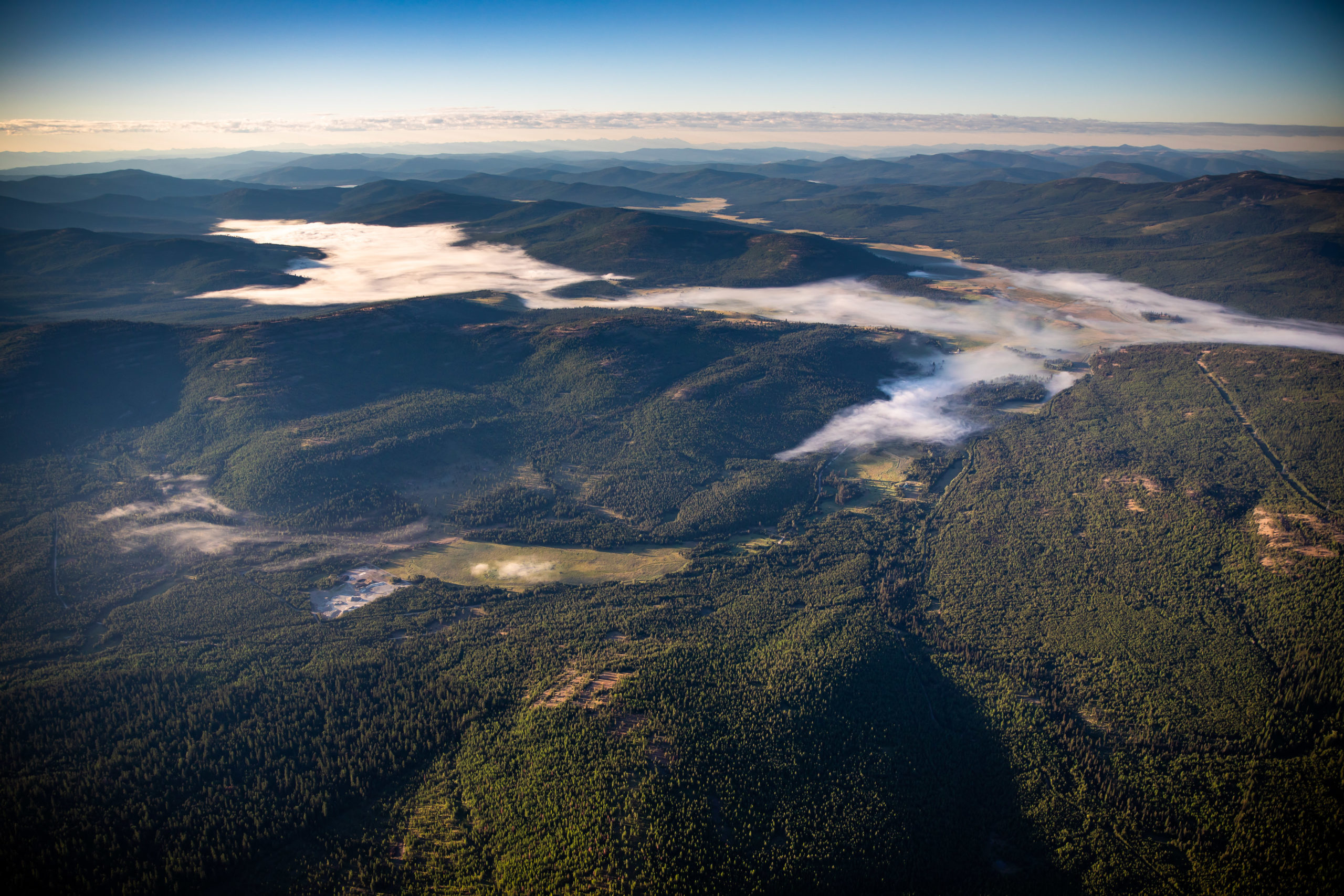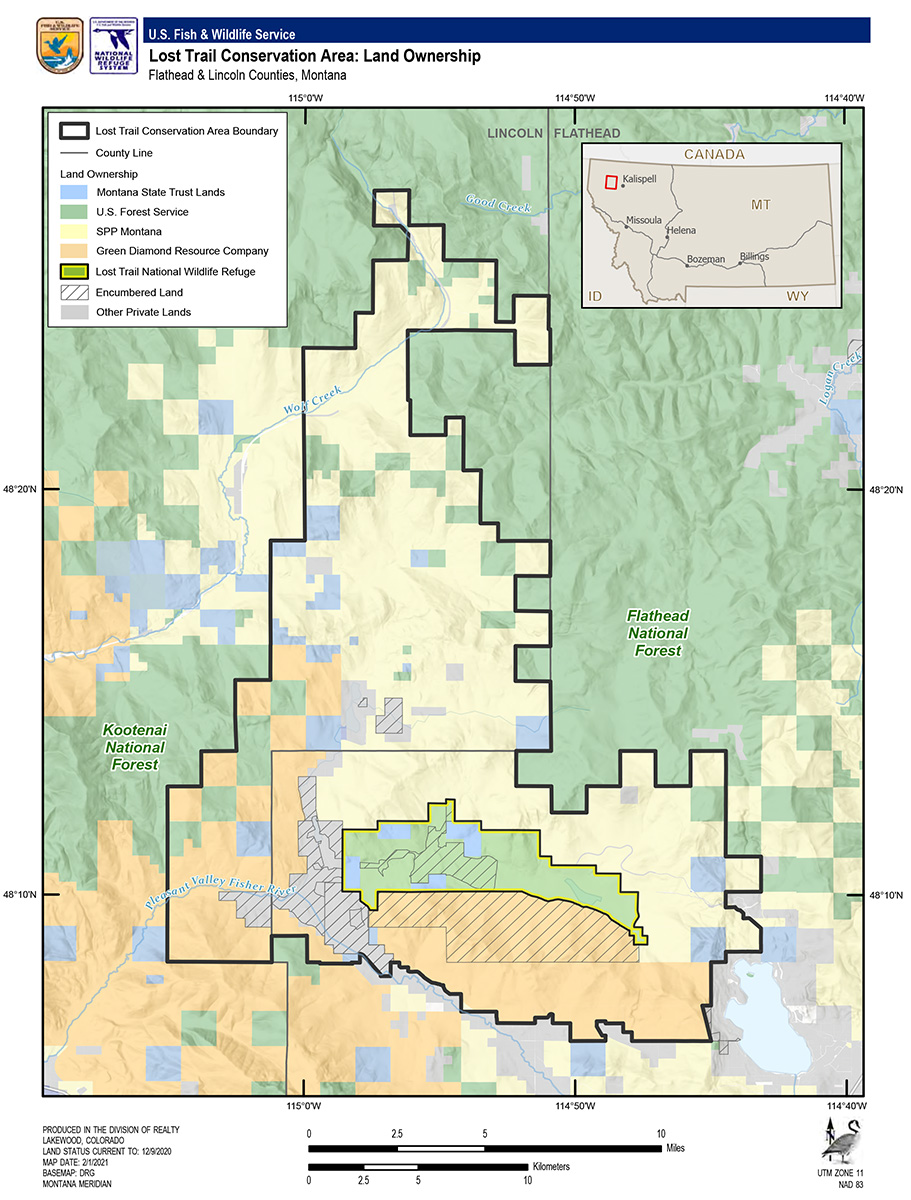FWS Approves Sprawling Public Lands Project at Lost Trail
Federal agency authorized to purchase easements of up to 100,000 acres of private timberland, protecting critical wildlife habitat from development and ensuring public access in perpetuity
By Tristan Scott
The U.S. Fish and Wildlife Service (FWS) on Tuesday approved a plan to safeguard up to 100,000 acres of privately owned timberland through conservation easements in Flathead and Lincoln counties, a move that would permanently protect the parcels from private development while also ensuring continued public access and sustainable logging harvests, as well as a wildlife corridor spanning the Kootenai and Flathead national forests.
The proposed project lands currently form a checkerboard of ownership girding the FWS’ Lost Trail National Wildlife Refuge, a 7,876-acre mosaic of wetlands, streams, prairie grasslands, forested hillsides, and rock outcroppings overlooking the Pleasant Valley near Marion. The majority of the acreage surrounding the refuge, however, has historically been owned and managed as corporate timberland, changing hands through a succession of land transactions that have cast the future of the region in doubt — most recently when Georgia-based Southern Pine Plantations, a real estate and timberland investment firm doing business as SPP Montana, bought out the previous owner, Weyerhaeuser Co.
With a track record of flipping large chunks of private forestland in the western and southeastern U.S., including selling parcels for private development in Idaho’s Payette River Valley, SPP’s purchase of the land raised immediate concerns.
But within days of its announcement, SPP attempted to allay those concerns and has since worked closely with FWS to furnish permanent protections on the Lost Trail Conservation Area. With Tuesday’s announced authorization of the project, federal resource managers will now begin submitting funding proposals through the Land and Water Conservation Fund (LWCF), enabling the agency to secure grant money to acquire the easements from SPP.

Indeed, the timing of the Lost Trail Conservation Area’s federal approval is serendipitous in that it follows the U.S. Senate’s bipartisan passage last year of the Great American Outdoors Act, which authorized full and permanent funding of the LWCF, allowing annual allocations of up to $900 million, for which projects like Lost Trail are ripe. That funding is derived from federal offshore oil and gas leases.
According to Ben Gilles, the FWS’ western Montana National Wildlife Refuge Complex Project Leader based out of Great Falls, having a willing seller like SPP is critical to bringing a project of this scale to fruition, and the property’s high development potential means that any unnecessary delay could potentially jeopardize the outcome.
For example, SPP recently sold 291,000 acres of its Montana holdings to Green Diamond Resource Company, a Washington-based forest products company that has committed to pursuing easement negotiations, both at Lost Trail and elsewhere in the region. Still, the pace at which the land transactions have occurred is testament to the property’s investment potential, Gilles said.
“That just underscored the urgency of us needing to secure funding while we have willing sellers,” Gilles said. “These companies are being great stewards of the land, but at the end of the day they are for-profit businesses and they aren’t going to wait around for years for us to come up with funding. So it’s incumbent upon us to obtain that funding, and certainly having LWCF fully authorized is a big step in the right direction.”
Once funding is secured, the newly approved Lost Trail Conservation Area would be established as a new unit of the National Wildlife Refuge System and would dovetail with another easement on SPP land proposed for acquisition by Montana Fish, Wildlife and Parks (FWP), a state agency that has long identified the habitat surrounding Lost Trail as a missing piece of the conservation puzzle for fish and wildlife habitat, as well as recreation in Northwest Montana.
To fill in the gaps, FWP is working with the nonprofit Trust for Public Land to complete the Montana Great Outdoors Project, which would protect an additional 130,000 acres in the Chain of Lakes area immediately to the west of Lost Trail. The easements would also preclude development while ensuring sustainable timber management and providing permanent public access.
Collectively, these efforts would stitch together 317,000 acres of conservation work completed over the last 20 years that protects critical working forestland spanning from Glacier National Park through the Cabinet Mountains Wilderness to the Selkirk and Coeur d’Alene mountains in Idaho.
The area provides critical wildlife habitat for a suite of species, including grizzly bear and Canada lynx. It also provides a vital migration corridor for elk and mule deer, and provides over 6,000 hunter-use days per year, making it one of the most popular elk-hunting districts in Northwest Montana.
According to a draft Land Protection Plan released Tuesday, over 28,000 acres in the Lost Trail project area are held by public agencies or are protected with existing conservation easements. Of the remaining unprotected private land, nearly 97% is owned SPP Montana, which, like its predecessors, allows for public hunting and other recreation on the property.
“But the company may consider subdividing and selling these lands for development,” according to the plan. “Conservation easement acquisition would guarantee that these lands remain intact and open for future generations to enjoy. These lands have been used by the public as de facto public lands for generations, and there is concern that subdividing and selling these lands could lead to reduced public access and habitat fragmentation.”
The Lost Trail Conservation Area enjoys strong bipartisan support, and Gilles said the federal agency’s environmental assessment drew public feedback overwhelmingly in support of the project, resulting in its Finding of No Significant Impact (FONSI).
“The Lost Trail Conservation Area allows the Service and our partners to serve not only Montanans, but everyone who enjoys the wilderness, wildlife and natural beauty of Big Sky Country,” FWS Regional Director Noreen Walsh said in a prepared statement.
“The lands in the Lost Trail Conservation Area are extremely important to Flathead County,” added Flathead County Commissioner Randy Brodehl. “The timber helps secure local jobs. Those lands also are a favorite for hunters and other recreationalists. We are excited to work with the private landowners in the area to protect those resources.”
FWP Director Hank Worsech also cast his agency’s support behind the Lost Trail project, noting that it is “similar to conservation easements that [FWP] works hard to achieve with willing landowners to benefit working lands, public access and wildlife habitat.”
“These projects reflect the good collaboration and stewardship that help define Montana,” Worsech said.
U.S. Sen. Jon Tester, D-Montana, also praised the approval of the proposed conservation area, noting the importance of funding enabled by the full authorization of LWCF, which he has fought to secure for years.
“Public access is a key driver of the economy in Northwest Montana and is critical to our state’s outdoor heritage,” according to a statement from Tester’s office. “It’s good news that conservation easements will be made available to private landowners through the Lost Trail Conservation Area, which will provide an opportunity for Land and Water Conservation Fund dollars to be put to work right here in Montana, and this project will help protect access to prime forest lands, create jobs, and ensure folks can continue enjoying this one-of-a-kind landscape for generations to come.”